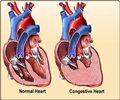Report says compared with oral corticosteroids, use of the beta-blocker propranolol for treatment of infantile hemangiomas (IHs) was associated with higher rates of lesion clearance,

Cynthia J. Price, M.D., formerly of the Miller School of Medicine, University of Miami, and colleagues sought to evaluate the use of propranolol in patients with IH but with no cardiac abnormalities, and to gather information about optimal length of treatment, associated adverse effects and relapses when treatment ends. Between February 2005 and October 2010, they conducted a multicenter, retrospective review of the medical charts of 110 patients with IHs. Researchers used photographs and clinical examination results to divide patients into two groups: those whose IH was cleared by 75 percent or more (defined as a reduction of at least 75 percent in the tumor's volume) and those whose tumor clearance was less than 75 percent.
On average, treatment with propranolol lasted for 7.9 months and treatment with oral corticosteroids lasted 5.2 months. Of the 68 patients who received propranolol, 56 (82 percent) had tumor clearance of 75 percent or more, compared with 12 (29 percent) of 42 patients who received oral corticosteroids. Adverse events occurred in three patients receiving propranolol and all 42 patients receiving corticosteroids. In patients who received propranolol, relapse occurred after treatment ended, but improvement was noticed after another round of treatment. Eight patients (12 percent) in the propranolol group and 12 patients (29 percent) in the corticosteroid group needed further surgery. Overall, the average per-patient costs of treatment were $205.32 and $416.00 in the propranolol and oral prednisolone groups, respectively.
"In conclusion, our study showed that propranolol therapy was more effective in lesion clearance, required fewer surgical referrals after treatment and demonstrated superior tolerance, with minimal adverse effects," write the authors. "Propranolol proved to be safe in treating IH in our patients as no major adverse effects occurred. Also, propranolol therapy was more cost-effective, with a cost reduction of more than 50 percent per patient."
Source-Eurekalert










